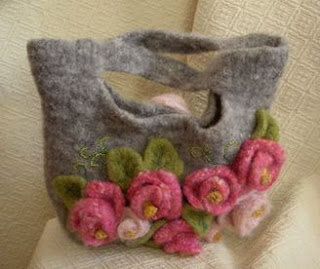By Deanne Blackhurst
If you've never heard the term felting, then you are not alone. Despite the fact that this process has been used for thousands of years, for many people the process of hand transforming carded wool into felt is a relatively new and unknown craft. In its most basic form, felt is created by taking wool roving and repeatedly squeezing it together by hand, applied pressure or with the use of small barbed needles. This force causes the wool fibers to tangle in millions of tiny knots that stay joined because the animal fibers are coated with microscopic scales. These tiny scales hold the fiber knots in place and create a fabric that is both tight and dense.
Felting works with any animal fiber including wool, alpaca and cashmere roving or yarn. Plant or synthetic based yarn or fibers don't have tiny scales and won't felt. Different types of fiber produce felt with different and unique qualities, so it's important to experiment a little before you begin a large and involved felting project.
Felting as a form of art is quite popular in many of the European countries; however it is only in the last decade that an interest in working with fibers to create decorations, scarves, purses and 3D art has begun to flourish in the U.S. Let's examine some different methods of felting and the type of results they produce.
Nuno Felting
Nuno felting is a Japanese technique that uses hot water, soap and a rolling process to meld loose animal fibers with sheer fabrics such as silk gauze. When mixed the silk retains its shape and stability but incorporates its original smooth texture with the added softness and rich color of the dyed fibers. You can find multiple examples of this process by searching the internet for felted silk scarves.
Flat Felting
Similar to the Nuno felting process, flat felting uses hot water and soap, but instead of binding the wool fibers to fabric, they are simply bound to each other. Different colors of fiber can be combined for an interesting marbling effect. For a thin flannel that is pliable and can be stitched together, only a couple of layers of fiber are used. For a thicker and more firm end product, more layers are piled on.
Knit Felting
Everyone knows that if you wash and dry a wool sweater, it will shrink making it unwearable, but that's what a number of crafters are trying for. Old wool, angora and merino sweaters are being recycled for new handicraft projects by purposely shrinking and felting them in the wash. Other clever crafters knit extra long and loose strips, and then felt the finished product in the washing machine. In both cases, these newly felted fabrics can then be sewn into bags, scarves or other felt products.
Needle Felting
This is a dry process where chunks of fiber are repeatedly stabbed with small barbed needle tools. This method is often used when creating small felt objects such as Christmas tree decorations or appliqués like flowers, stars etc...
3D Felting
Like sculpting with wet clay, 3D felt sculpting involves adding various shapes of and sizes of fibers to each other and needle felting them into place. Different color accents can also be added using the same technique. Soft sculptures including animal and doll figures can be created by roughly hand shaping clumps of fiber, and then detailing them with felting needles.
What makes the process of felting both fun and satisfying is the burst of creative energy that comes from taking various textures and colors and combining them into something new and beautiful like a one of a kind scarf or doll. Not up to felting yourself? Don't worry. There are many amazing felted products available to purchase online.
Deanne Blackhurst is a freelance writer for Alana Marketing, a company that specializes in promoting promising new artists and their products to the general public. They carry the Whimsical line of Sidney the sheep, a hand felted collectable gift for the yarn and craft lover. Visit us at http://www.alanamarketing.com
skip to main |
skip to sidebar
Tea Cosy Folk

Hand made tea cosies, Exclusive designs ~ The perfect gift
Tea Cosies with Character
www.TeaCosyFolk.co.uk
Do you enjoy arts and crafts? Do you friends and family often find you busy crafting? Well this is possibly the blog for you, crammed full of arts and craft ideas for the garden, home and family. You'll always be busy crafting now!
Quick Craft Links:
Search This Blog
TeaCosyFolk.co.uk

Hand made tea cosies, Exclusive designs ~ The perfect gift
Tea Cosies with Character
www.TeaCosyFolk.co.uk





